Dee Estuary Birding
Monthly Newsletter...
October 2023 Newsletter
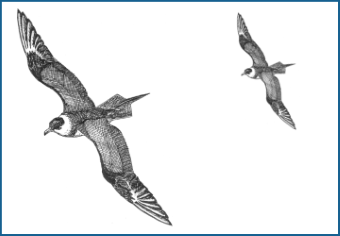
PEEEXoted Geese

What a horrible year 2023 has been for the
environment. With Global Warming, Bird Flu (HPAI) and Insect Armageddon
to name just three major issues. So I thought I'd try and cheer us all
up by remembering some good times when exceptional numbers of birds
have been present on the Dee Estuary and the Wirral coast. But it's not
just about remembering the past, it's also about anticipating the
future as many of these exceptional numbers could be repeated, indeed
two of
these events have taken place in the past two years.
I've chosen nine species* when exceptional numbers have been present here, and I have only chosen those which have been exceptional in a national context, not just local. I hope you enjoy reading about them.
* Three of those species are lumped together in one
section under 'Terns' - Sandwich, Arctic and Common.
Common Scoters
It was October 21st 2016 and one of those lovely
autumn days when the sea was like a mirror - and covered in Common
Scoters. 40,000 of them! These were counted from Hoylake when the birds
were off East Hoyle Bank with ideal conditions - no wind and excellent
visibilty. The video below, by Jane Turner, gives an idea of what it
was like that day.
Video shows about half of the vast numbers of Common Scoters off
Hoylake on October 21st 2016 - video by Jane Turner.
As far as I know that remains the highest ever number of Common Scoters counted in the UK from a single site. But perhaps the most surprising thing about that count is that it wasn't actually a huge suprise as we'd been seeing really big numbers since the winter of 2013/14. The first five-figure count of Scoter ever made off the Dee Estuary was made in January 2014 with 12,000, followed by a whopping 27,000 counted from Hilbre in March that same year. We then had at least 22,500 in March 2015 and 36,000 in February 2016 before the 40,000 in October.
But we've not finished with exceptional numbers of Scoters yet. It wasn't until aerial surveys carried out between 2004/05 and 2010/11 that it was realised just how important Liverpool Bay was for them, and the mean peak over those five years for the whole of Liverpool Bay was found to be 57,995 - compared to previous estimates of no more than 10,000. Because of those numbers, and a large gathering of Red-throated Divers, Liverpool Bay was made into a Special Protestion Area. But more recent aerial surveys using better cameras and some clever bird identification software have come up with a massive 160,000 Common Scoters in Liverpool Bay! (as per The Birds of Wales, 2021).
Great Crested Grebes
In the winter of 2005/06 the Dee Estuary was
something like the 100th most important site for Great Crested Grebes
in the country with a max count of 33, not a very impressive statistic
for one of the foremost wetland sites in the country. But the following
winter it was the eighth most important and by 2010/11 it was the
second
with more birds present than the traditional major sites in Northern
Ireland such as Belfast Lough and Loughs Neagh and Beg. What had
happened was that we started seeing, and counting, Great Crested Grebes
off North Wirral whereas previously the only ones recorded were in the
estuary itself, mostly in the main channel off Bagillt.
Out in the open sea Great Crested Grebes are not
easy to count - firstly they are little more than grey dots out there,
and you have to distinguish them from the black dots (Scoters) and the
white dots (gulls), not to mention divers and auks! But if there is any
wind and a sea running you are wasting your time anyway, so you need a
flat calm and, lastly, good seeing conditions - no mist or heat haze.
All this I found out as the majority of the counts in those years were
mine. Having been used to counting just a handful of scattered Great
Crested Grebes in the estuary to see big rafts of them was just
amazing, I'd never seen rafts of Grebes before!
I found the best place
to count was from a bit of high ground behind the promenade at Dove
Point (Meols). The first one I did was in November 2006, and I got 378.
There were then several counts of over 400 until a massive 1,195 were
counted by Jane Turner in January 2011 from her rooftop 'hide'
overlooking Hoylake shore. For the next five years there were several
counts of more than 900, and over that period the Dee Estuary remained
the second most important site for Great Creseted Grebes in the UK,
behind Dungeness and Rye Bay where numbers were about double ours.
Since 2015/16 max numbers have dropped to around 300 annually but it
was good to see more were present this last winter, 2022/23, with 589
off Meols in November.
Black-tailed Godwits
There is a small field, close to my house in Caldy,
which is probably the most important site for moulting Black-tailed
Godwits in the United Kingdom. This is the Caldy Wildfowl Collection
which provides a safe haven for them, sheltered from gales and with
fresh water available to drink and wash in, yet only a short flight to
the mud off Thurstaston. Counts peak here in August, they reached an
incredible 6,230 in 2020, the next two years they were a few hundred
below that but on August 20th 2023 I counted an amazing 6,350. This is
in one two acre field (in comparison Burton Mere Wetlands is 250
acres), in 2021/22 the whole of the Wash had just a few hundred more
with 6,930.
But there's more, on that same date of August 20th
2023 there were another 4,000 at RSPB Oakenholt, and also 3,600 on the
Mersey Estuary - making a total of 14,000 and all counted at high tide
for the Wetland Bird Survey. That's a third of all the Black-tailed
Godwits in the United Kingdom, exceptional numbers indeed.
Knots
I have a distinct memory as a boy sitting in the
window of West Kirby Sailing Club watching Knots. I'd been out sailing
with my father in his old Solent Scow so the tide was on the ebb, and
I'm pretty certain it was August and the year was 1963. What I saw was
flock after flock after flock flying past heading from their West kirby
roost towards Thurstaston. Thinking back now about what I saw I can
well imagine the total was well over 100,000.
My childhood observations may seem a bit vague, but
before systematic counts started in the 1970s that was how it was. The
year following my recollections the first Cheshire Bird Report was
produced and they certainly helped as at least records were written
down. In 1965 "The autumn peak in the Dee Estuary probably occurred on
or about November 13th; ca. 100,000 at Red Rocks was considered a very
conservative estimate", and 1966 "The peak at Hilbre occurred on or
about October 30th when several
hundred thousands were present. The difficulties of estimating
such a flock with any degree of accuracy are immense."
In the 1960s many of the Knots roosted on the Hilbre
islands with Little Eye completely covered in them at high tide, and
West Kirby
Shore was also immensly important. But by the 1970s human disturbance
had caused many Knots to desert Hilbre and West Kirby as their main
roost site - sea anglers on Little Eye and excercising race horses on
West Kirby Shore were major contributors to this disturbance. We still
do get large numbers of Knots on the Dee Estuary, there have been
several counts both at high and low tide between 40,000 and 50,000
since the turn of the century and what a great wildlife spectacle they
make. I watched a flock of 30,000 over West Kirby shore a couple of
winters ago, they were swirling around putting on a fantastic display -
try to imagine what 10 times that would look like!!
Terns
The 1960s and early 1970s saw some remarkable
reports of huge numbers of terns. The first report below, in 1965, was
from Hilbre and is the only one which mentions Sandwich Terns when
about 9,000 were counted on September 5th - despite there being a lot
less pairs breeding around the Irish Sea at that time then there are
now. The other reports don't distinguish between Arctic and Common
Terns but I suspect that the majority were probably Arctic Terns coming
down from Scotland, Scandinavia and, perhaps, even north-west Russia -
and at that time the River Mersey, and the channel going up towards
Formby, was probably being used as a staging post for them. We still do
get thousands of Arctic Terns in Liverpool Bay but these days they
mostly pass through Morecambe Bay on their way north in spring to
breed, with only
small numbers recorded on their return.
Hilbre
Bird Report 1965: On August 21st, 26th and
September 5th literally thousands of mixed terns were off the island,
certainly in such numbers that had not previously been recorded by the
Observatory. The observers found it impossible to specifically identify
and count each species so the estimates of numbers refer mainly to the
Common, Arctic, Little and Sandwich Terns. The estimates were as
follows:- August 21st and 26th - c5,000 and at least 1,000
respectively, Sandwich and "Comic" Terns predominated with a few
Little. September 5th - c10,000. Heavy movement to the north-east
during the two hours 05.30 - 7.30. Majority Sandwich, then Little, with
only a few "Comic".
Cheshire Bird Report 1969:
Vast numbers of 'Commic' terns were present
in the mouth of the Mersey in late August and early September, whilst
these were largely on the Lancashire side of the river, big numbers
overflowed to the Cheshire side. From the Isle of Man boat on September
1 it was seen that dense clouds of terns stretched all the way from the
docks to the Formby Light, a distance of several miles. this
congregation must have numbered tens of thousands and at the same time
there were at least 1000 off Seacombe on the Cheshire side. At this
period numbers passing Hilbre were reported at 500 per day, 2000 on
August 16.
Cheshire Bird Report 1970: 5-6000 milling around feeding over the outflows from Birkenhead Docks....... the rate was 198 per minute (passing the bow of a ship) and the movement was watched in progress for an hour.
Cheshire Bird Report 1972: At Hilbre up to 600/day were passing... in the Mersey there was a count of 4200/hour over a period of three hours passing Seacombe in the second week of September.
Cheshire
Bird Report 1973:.... beginning of
September... on a rising tide when 12,000 were counted moving up river,
in the space of an hour, at New Ferry.
Leach's Petrels
Our Liverpool Bay coasts are rightly renowned for
being the best place to see Leach's Petrels in the country - but only
in the right weather conditions. Well, the weather was certainly right
in 1978 as described below:
Cheshire Bird Report 1978:
Persistent NW gales in September resulted in
the largest ''wreck'' yet recorded in Cheshire.
A dawn to dusk watch was maintained at Hilbre on most days throughout
the month. Birds first appeared on 11th with large numbers continuing
'through to 1st October. Counts from Hilbre as follows:
| Sept |
11th |
12 |
16th |
59 |
20th |
3 |
28th |
28 |
||||
| 12th |
20 |
17th |
663 |
25th |
4 |
29th |
19 |
|||||
| 14th |
50 |
18th |
34 |
26th |
116 |
30th |
139 |
|||||
| 15th |
328 |
19th |
14 |
27th |
959 |
Oct
|
1st |
4 |
On both 15th
and 27th the highest hourly counts were obtained about 3 hours after
the wind dropped and just before dusk. Counts refer to birds passing
west
and exclude small numbers passing east.
Along the north Wirrral shore the
highest accurate count was of 505 moving west off Leasowe between 9am
and 3pm 17th and there were 400 or more there in 4 hours 30th.
ln the Mersey at least 2 to 20 per day were counted off
Seacombe and New Brighton between 11th September and October 1st. Peaks
of 35 on 17th and 27th coincided with high counts at Leasowe and
Hilbre. Early
on 30th quite phenomenal numbers were present, with some hundreds off
Seacombe Ferry, and many had penetrated even further up the river. On
the ebbing tide an incredible number moved out of the river past large
numbers of observers stationed at New Brighton. No accurate counts have
been submitted, but a conservative estimate is of 800 petrels. The
lack of very large numbers off Hilbre on this date is interesting.
It has been suggested that upwards of 3,500 Leach's Petrels passed the
Wirral coast in September.
The following is also about that remarkable passage during September
1978. It's an
extract from J.D. Craggs'
classic "Hilbre" book (1982) and taken from an article included
in the book written by Ann and Tim Cleeves, Hilbre wardens at the time:
"On the 27th September the sea-watching hide was manned for 12 1/2
hours. For the first 10 hours, petrels averaged about 60 an hour, but
one of the observers' resolve began to weaken when the hourly count hit
only 42 after a slight but steady decrease over the previous four
hours. However, with the observatory record standing at 663 birds in 8
hours, he was persuaded to stay. The next hour the count hit 83, and
the next 214. The reluctant observer realised that he would have to
resign himself to remaining in the hide until it was completely dark.
The count for the last hour was 130 birds and the total for the day was
959."
Redwings
There was a massive Redwing migration through our area on October 19th 2022. It was estimated that at least 20,000 flew over Thurstaston that day and they were recorded in their thousands along the north Wirral coast, over Hilbre and down the estuary, as well as all over inland Wirral. But by far the biggest count, and the biggest single site count of Redwings ever made in the UK, was at Crosby Marine Park where an experienced migration watcher counted an amazing 122,600 all heading south - i.e. straight towards the north Wirral coast!
This big movement started in southern Norway and
Sweden on the evening of the 18th, the weather radar showed them flying
up in one huge mass before starting to fly out into the North Sea. Huge
numbers headed due south and ended up flying along the west coast of
Holland on the 19th. Others flew south-west and thousands were heard
crossing the County Durham coast at Jarrow overnight. By the morning
the large majority were recorded heading south over Lancashire, the
eastern half of Yorkshire and into Merseyside and Cheshire.
An article, 'A
Massive Redwing Migration', was published in my December
2022 Newsletter and shows maps of exactly where the birds were and
the routes they took.
I end with a quote from an observer who was at
Thurstaston in the afternoon of the 19th "I have just walked through
Dawpool NR, every berry tree
was alive with them. They where like locusts. Then a Sparrowhawk
spooked them all, what a spectacular sight."
Richard Smith
up shortly after first light on September 13th, by the time I got downstairs it must have been around 7.30am and I was somewhat surprised to see six texts and eight WhatsApp messages all of which had come in over the past 30 minutes. It was the first major influx of Pink-footed Geese of the autumn, and the number of texts and messages nicely demonstrates how much people love to see them!
There was nothing particularly remarkable about the
numbers that morning, the total moving was probably in the region of 2
- 3,000, but lovely to see. These days we are used to seeing large
flocks of Pink-footed Geese flying overhead and feeding on the marshes
and adjacent fields from September to April, but that certainly wasn't
always the case. So I thought it would be of interest to review the
status of Pink-footed Geese on the Dee Estuary including the recent
remarkable increase (and the even more recent and remarkable increase
on the Mersey Estuary!) and put it in a national context.
But first I refer you to 'Geese on the Dee Estuary - Part 1' (Ref 1) which was written just at the start of the Pink-footed Geese increase here and published in the Dee Estuary January 2012 Newsletter. It gives a nice summary of historical records going back over 100 years and more - so there is little point in me repeating the same in this article.
Pink-footed Geese (Anser brachyrhynchus) in the United Kingdom
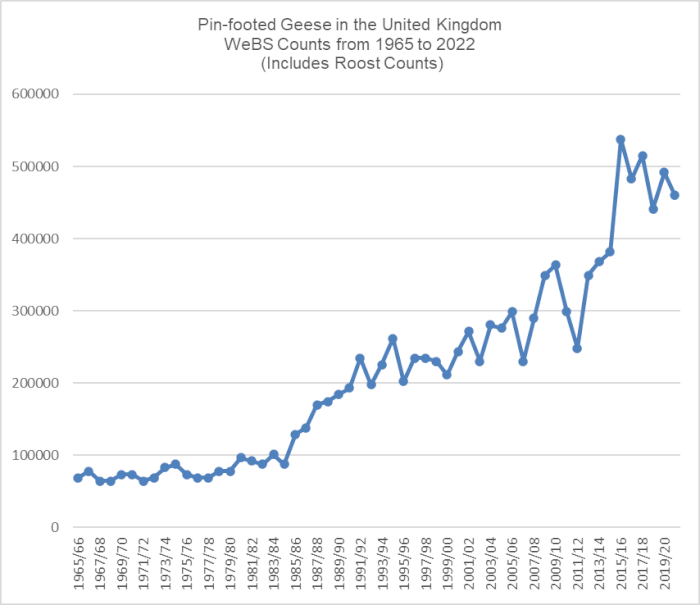
Regular counting of Pink-footed Geese started in the
1960s, in 1965/66 there was just under 70,000 in the country. After
breeding in Iceland and east Greenland the counts showed that they
first flew to Scotland, arriving in September and October. Many stayed
the winter there but the Ribble estuary and south Lancashire potato
fields had also long been important for them and by the early 1970s
counts of at least 10,000 were typical there, peaking in mid-winter.
1975 saw the establishment of Martin Mere (Wildfowl Trust) in south
Lancs which gave them a safe roost site and a large area to feed in
free from shooting (the Wildfowl Trust had bought the shooting rights
in the surrounding fields). Helped by safe roosting sites like Martin
Mere numbers slowly increased nationally so by 1983/84 the count went
above 100,000 for the first time. However, change was afoot when the
geese discoved the delights of sugar beet in the coastal fields of
North Norfolk. None were recorded here in the winter of 1981/82 yet by
1989/90 there were 15,600 (numbers continued to increase here with a
phenomenal 122,000 counted in 2003). No doubt helped by their new diet
of sugar beet the period between 1984 and 1990 saw a big rise
nationally and they more than doubled to 200,000, a slower rate of
increase then followed but by 2008 they reached over 300,000 for the
first time.
With total numbers now around 300,000 many goose experts thought that counts would plateau out at that high level, but everyone was surprised when in 2015 there was an incredible 530,000 counted - more than double the 2011 total. It was during this period that we saw the start of a near exponential increase of Pink-footed Geese on the Dee Estuary, which nicely brings us to the next section.

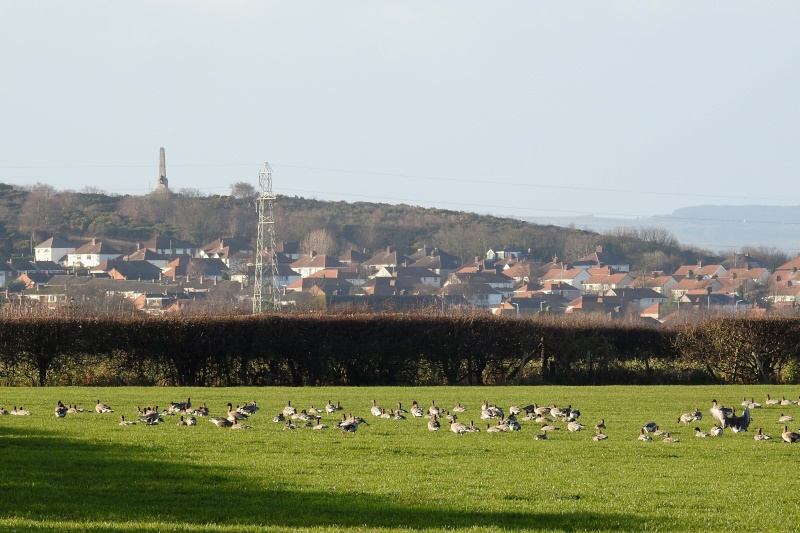
Pink-footed Geese on the Dee Estuary
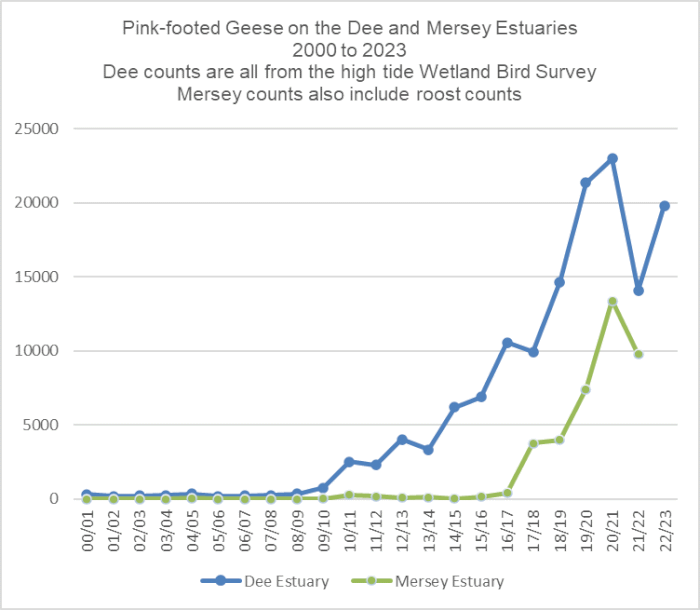
As you will see if you read Ref 1, Pink-footed Geese were present in the Dee Estuary before World War II but were driven away by the industralisation at the head of the head of the estuary and by over-shooting. Despite the huge rises in numbers nationally the geese stayed away from the estuary for over 70 years, with only the odd small flock seen (apart from 1979 when there was a significant cold weather movement which peaked at 1,500 in February that year). But the long absence has made their return all the more exciting and below I detail some of the highlights.
Looking back at the WeBS (Wetland Bird Survey) data
there were signs that the geese were returning at the beginning of the
century with an average maximum winter count of 194 from 2000 to 2009,
compared with the previous 20 years when the average count was just 27.
These were birds counted on the ground, but we sometimes saw much
larger flocks passing overhead. Pink-footed Geese leave North Norfolk
in January and it was these birds we sometimes saw flying up the
estuary then heading for south Lancs. Probably the largest number of
Pink-footed Geese ever recorded on the Dee Estuary up to that point was
seen in 2007, and I quote from the February 2007 Dee Estuary Newsletter:
A spell of still sunny
weather from January 22nd to 24th (2007) was an opportunity for
Pink-footed Geese to move across the country from Norfolk to South
Lancs. Many passed overhead through the Dee Estuary with 850 on the
22nd, 350 on 23rd and a remarkable 4,500 - 5,000 on 24th. The first
flocks appeared around 11am each day, just enough time for the birds to
have left the Wash at first light and travelling at 30 - 40mph over a
distance of about 120 miles.
But it was during the two cold winters of 2010 when
Pink-footed Geese started to over-winter in significant numbers, this
was from the C&W 2010 Bird Report:
Numbers probably not seen
since the early 20th century overwintered during both winter periods on
the Dee marshes. The two highest counts in the early winter period were
700 at Parkgate Marsh on Jan 2nd and 670 at Burton Marsh on Jan 31st.
Large numbers were also recorded at IMF, either on the reserve or
flying over between Burton Marsh and Shotwick Fields, Flintshire, with
600 on Feb 19th and 750 on both Mar 1st and 3rd. In the late winter
period numbers had already reached 600 by Nov 18th at Parkgate Marsh,
followed by 700 on Dec 7th and 750 on Dec 19th. Numbers peaked on Dec
23rd and 24th with counts of 1000.
Later on in that winter (2010/11) those counts were
soon bettered during the spring tides in February when 2,000 were
flushed by the sea from Parkgate Marsh - I well remember looking in
amazement at that huge number of birds, and the noise they made. The
following winter was similar and in February 2012 they took to feeding
on the marsh close to Parkgate Promenade giving wonderful views.
Numbers continued to increase with notable flocks including 4,500 off
Gayton in November 2013, and in March 2017 7,000 were seen in the air
together at Neston. Hundreds also started feeding in inland fields all
along the west coast of Wirral, around Shotwick Fields, Burton,
Parkgate, around Irby and Pensby, Thurstaston and between Greasby and
Hoylake. All this meant that skeins were constantly in the air over
much of west Wirral as the geese moved between the coast and inland
fields.
By the winter of 2017/18 several hundred took to roosting overnight on the edge of Heswall Marsh, at first light they moved inland flying over Thurstaston beach in several skeins. They still do this and it's a wonderful sight - on December 24th 2022 4,855 were counted coming over, fantastic! Other notable counts in recent yours were at least 10,000 at Burton Mere Wetlands during a big spring tide in March 2020, and 12,500 were seen flying into roost on the edge of the marsh at Neston and Parkgate on October 25th 2021.

Arriving and Departing
The first ones back from Iceland are usually
recorded during the first two weeks of September, and it's quite likely
that some may well make it here without stopping, a journey of around
950 miles. The first flock in 2021 arrived very early, on September
1st, but it's usually a week or two later - this year, 2023, the first
small skein was spotted on the 7th. By mid-September we can start
getting quite large numbers arriving, although the flocks tend to be
scattered so difficult to count, and by early October thousands will be
here; for example 5,000 were counted from Denhall Quay on October 8th
2020.
You would have thought January was too early for the geese to be thinking of heading back north, but that is what the Pink-footed geese in North Norfolk do with just a few stragglers left by early February. I've already described a big movement of Norfolk birds flying through the estuary in January 2007, but since the big rise in numbers here it's difficult to tell local from cross-country movements. However, recently we've seen three big flocks heading north in late January and early February and these are likely to be birds moving from Norfolk - 4,220 which roosted on Heswall shore overnight then flew north on February 3rd 2021, 5,000 flew north over Thurstaston and West Kirby at first light on January 28th 2022 and 6,330 north over Heswall shore on 22nd January 2023.
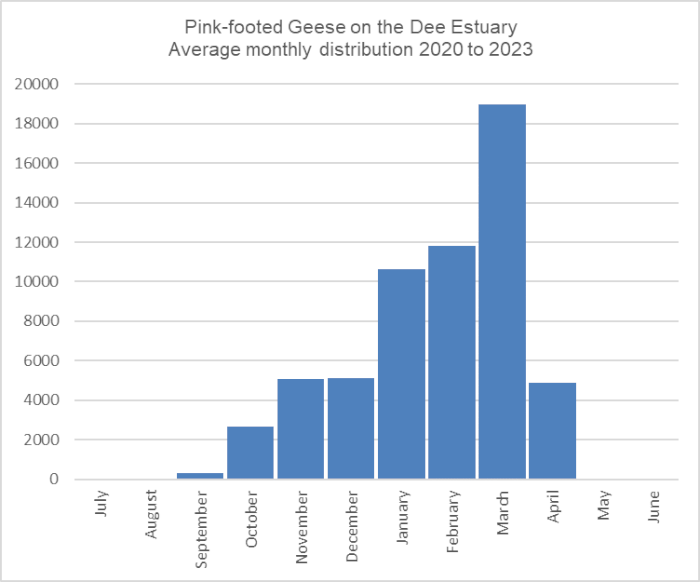
In contrast to Norfolk the Pink-footed Geese on the
Dee Estuary actually increase in numbers in January and February, and
peak in March, as the bar chart shows. My guess is that the surge in
numbers in January is driven by geese which have left Norfolk some of
which then stay on the Dee Estuary for the rest of the winter. As
winter progresses, the geese spend more time grazing the saltmarsh off
Parkgate and in late winter, with the cessation in shooting, they move
onto Burton Marsh. On 16th February 2021 a remarkable 18,000 were
grazing on the saltmashes at Burton and Parkgate/Gayton.
April is when the Pink-footed Geese leave us, and it
is often spectacular. Each year is different but the normal pattern is
for large skeins to head out of the estuary at first light anytime
between late March until the third week of April. 8,000 flying past
Hilbre during the first two hours of daylight on April 17th this year
(2023) was exceptional, and a wonderful sight. Some years their exodus
is prolonged over several weeks such as in 2021 when the first flock
heading north was on March 30th and the last on April 28th, and the
total counted leaving over that period was 16,173. Often we don't see
them as they fly out at night and on April 13th 2021 a large flock was
heard flying over Hoylake around midnight, taking seven minutes to pass
over.
One exodus that sticks in my memory was on April 9th
2016 during a big spring tide, having been flushed from the marsh by
the inrushing sea the geese decided it was time to leave, and I quote
from my Newsletter for that month:
the most interesting
event as far as I was concerned was seeing the over-wintering flock of
Pink-footed Geese, probably around 4,000 strong at that time, leaving
the Dee marshes on the 9th at the start of their migration back to
Iceland. They left in many flocks, some several hundred strong, from
dawn to high tide, i.e. from 7.30am to 1pm. Many passed over my house
in Caldy and were seen from Hilbre and all along North Wirral. I was at
Heswall when a total of at least a thousand took off from the marshes
as the tide came in and headed north. It was certainly a mass exodus,
just awesome.
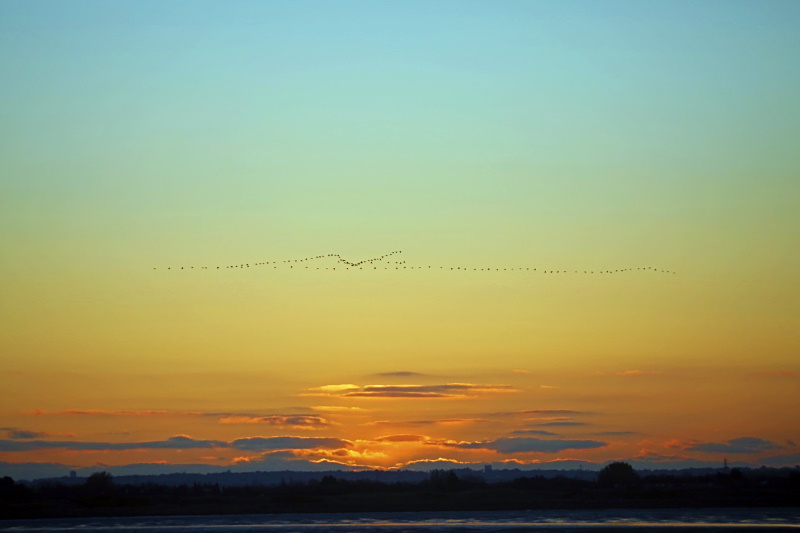
Pink-footed Geese on the Mersey Estuary
The recent rise in numbers of Pink-footed Geese on
the Mersey has been just as dramatic as on the Dee, although the
increase started several years later, in 2017/18 (see graph above). So
far the peak count is 13,400 in January 2021, and it's interesting that
the peak count is in January rather than March, as it is on the Dee, so
it seems highly likely that it's the same birds which are moving around
the area - as Pink-footed Geese do, of course.
Hardy (Ref 5), writing just at the start of WWII, says "small fights still visit the Mersey marshes, Ince and Stanlow" but, again like the Dee, they were largely absent for many years and a look at the WeBS counts from 1965 reveals mainly counts of zeroes right up until the 1990s, an exception being a nice count of 850 at Ince during hard weather in January 1982 which also procuced plenty of other records across Cheshire that month.
Further up the Mersey Valley, at Woolston Eyes, they saw exceptional numbers of Pink-footed Geese in 2022 and I quote from their Annual Report (Ref 6):
October brought further,
but unexceptional, movements, until the final week when numbers rose to
levels never seen before at Woolston. On 25th October 1200 flew
east over No.4 bed, followed by 2000 in the same direction the next day
and 3600 also flying east in many skeins on the early morning of the
27th. The movement was reported to be over by 09.00 hours. This
was just the beginning of the huge numbers reported in the following
two weeks. Up to 4000 flew east at 08.20 on 30th October, but at
least 10,000 flew west over Latchford Locks in 20 minutes in the late
afternoon of 31st October, presumably going to roost on the Mersey.
These massive skeins continued to be reported daily in the first two
weeks of November, with birds flying east in the early mornings and
west in the evenings. The last breath-taking numbers were 8000 at
dawn on 10th November, 10,000 east on 12th November and a minimum of
10,000 flying west on 13th November. The observer of that count
considered that as many as 12,000 birds could have been involved.
By then these large noisy skeins had attracted the attention of the
general public, while workers from a factory adjacent to Woolston
waited to see the geese pass over each evening, and the local
Warrington Guardian newspaper published many positive comments of
people who had watched this great wildlife spectacle.
A Final Note
For further reading I would recommend Colin Well's
(retired RSPB Dee Estuary Manager) Pink-footed Geese account in The
Birds of Wales (Ref 7). Colin quite rightly points out that the
spectaular growth in numbers on the Dee Estuary during the second
decade of the 21st century has been greatly aided by the by the
creation of the large sanctuary area by the RSPB.
References
1. Richard Smith, Geese on the Dee Estuary - Part 1, Dee Estuary Birding January 2012 Newsletter.
2. Austin, G.E., Calbrade, N.A.,
Birtles, G.A., Peck, K., Shaw, J.M. Wotton, S.R.,
Balmer, D.E. and Frost, T.M. 2023.
Waterbirds in the UK 2021/22: The Wetland Bird Survey and Goose
& Swan Monitoring Programme. BTO/RSPB/JNCC/NatureScot.
3. Neil Friswell and Colin Wells, Dee Estuary and
North Wirral Foreshore Annual Report, 2022/2023 (and various previous
reports).
4. Cheshire and Wirral Bird Reports 1964 to 2021.
5. Eric Hardy, The Birds of the Liverpool Area,
T.Buncle & CO, Ltd, 1941.
6. David Bowman, Woolston Eyes Conservation Group, Annual Report 2022.
7. Rhion Pritchard et al., The Birds of Wales, Liverpool University Press, 2021.
8. Latest Sightings and Newsletter archives - http://www.deeestuary.co.uk/.Richard Smith
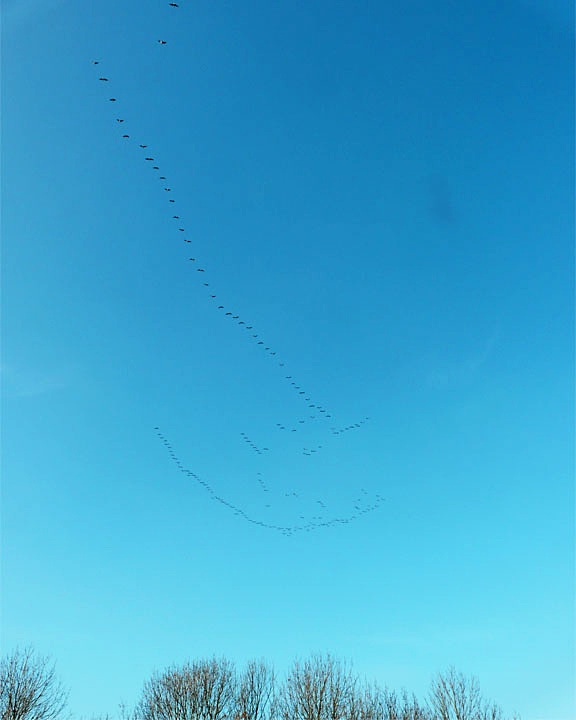
Colour Ring Report
August was a good month for spotting colour rings
and we recorded 80 different colour ringed birds from 14 species. Some
birds were seen several times (particularly Back-tailed Godwits) so the
total number of records will be well over 100. We are always pleased to
see any colour ringed bird and it's as pleasing to see the return of a
regular, which is like seeing an old friend again, as it is to see a
new one with the possibility of receiving an exciting life history. We
had a few from both categories in August and below I describe a few
highlights, but start with one seen in July.
Great Egret
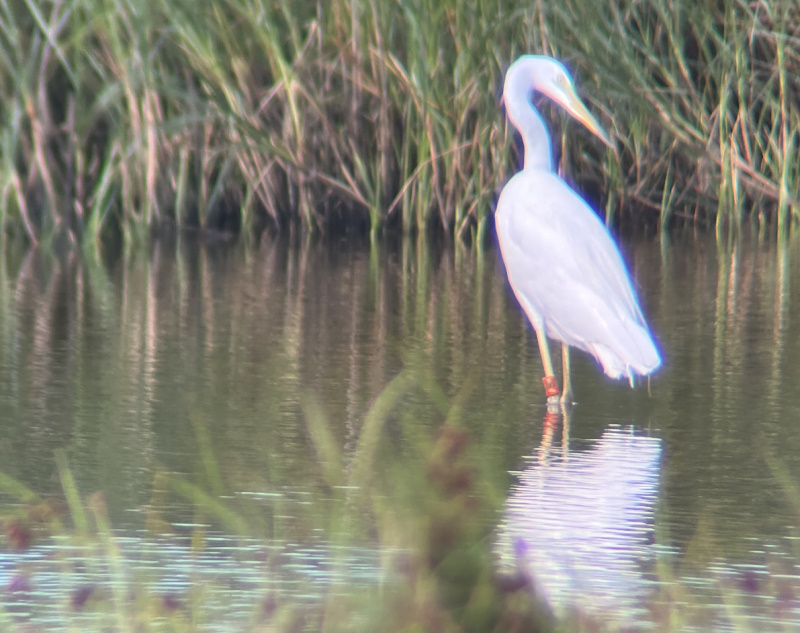
Red ring (ABM)
Ringed at Slapwick Heath, Avalon Marshes, Somerset, on April
29th 2022, as a chick.
Reported from Buckton, E Yorks, on 4th July 2022; from RSPB Blacktoft
Sands, E Yorks, between 12th & 15th July 2022; from Alkborough
Flats, Lincs on 17th July 2022; from Winterton, Lincs on 28th July; and
from RSPB Old Moor, S Yorks on 27th October.
Recorded at Burton Mere Wetlands on 9/07/2023.
Our first colour ringed Great Egret. It was one of
14 colour ringed chicks on the Avalon Marshes in 2022. Looking at the
reports these young birds dispersed widely with Yorkshire seemingly a
favourite destination. ABM's sibling, ABN, chose a different direction
and was seen on the Isle of Wight a couple of times that summer, whilst
others reached as far north as Dunbar (near Edinburgh).
Cormorants
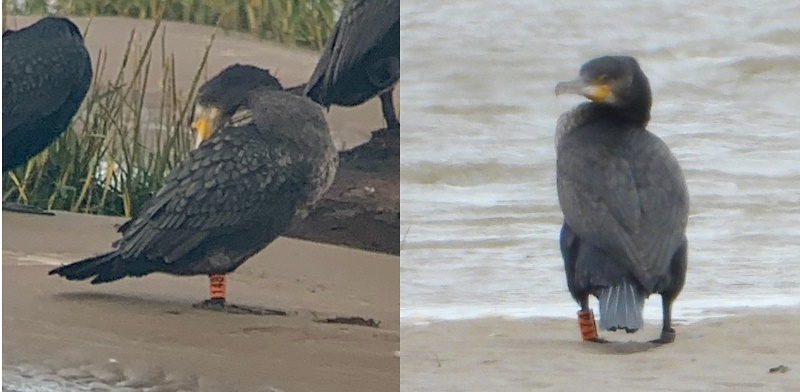
The Merseyside Ringing Group has been busy ringing
birds at Hale Duck Decoy, last month I reported several of their colour
ringed Little Egrets and in August we saw six Cormorants. These were
all ringed as chicks this year in May and June.
We can get several hundred Cormorants roosting out on East Hoyle Bank off Hoylake and Meols but usually far too distant to read rings. But on the 2nd and 3rd August the tide was high enough to push them closer to the shore without being too high to flush them all and we managed to get some distant photos of O-148, O-174, O-205, O-236 and O-254, with a sixth at Hoylake on 30th August - O-177. It will be interesting to see how these young birds disperse in the coming months and years.
Avocet
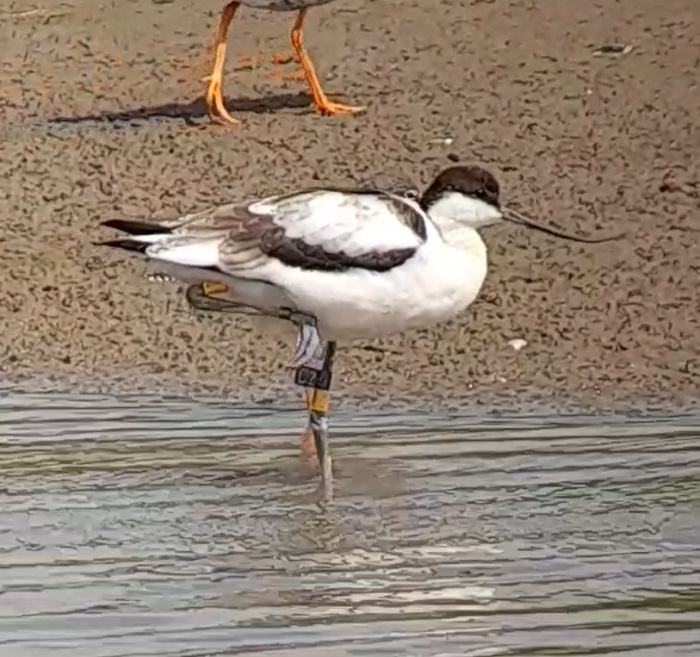
Blue Flag (C2)/Y-Y
Ringed at Conder Green, Lancs, on 07/07/2023 as a chick.
Recorded at Conder Green after fledgling several times in July, then at
Connah's Quay NR from 14/08/23 to 17/08/2023.
This is the first colour-ringed Avocet recorded here
since April 2019 when one was at Burton Mere Wetlands.
Redshanks
Considering that the Dee Estuary is the most important site in the country for Redshank we see very few colour ringed ones, but we got lucky this month with one seen three times, plus another three all recorded on August 18th. Two of them were returning birds from last year, also at Heswall, and they were both ringed at Ynyslas, Cardigan Bay. The other two are described below:
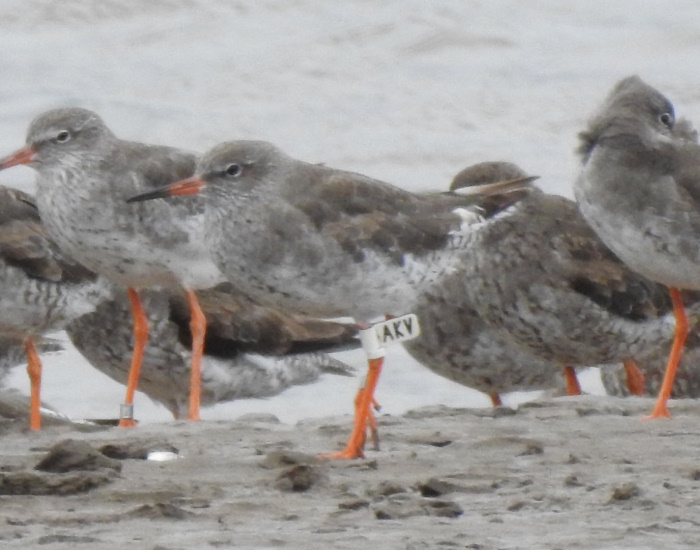
Redshank White Flag (AKV)
Ringed at Frieston Marsh on the Wash on 22/09/2020.
Recorded at Heswall on 18/08/2023.

Redshank N-N/LY
Ringed at Farlington Marshes, Langstone Harbour, Hampshire, on
01/09/2020.
Recorded at at Langstone Harbour several times until the end of
November 2020.
It then moved to Slimbridge (Gloucs) where it stayed all winter, last
seen on Feb 22nd 2021.
The next record was a single sighting back at Langstone Harbour in
October 2021.
There was just one record in 2022, in September when it was at
Sunderland on the Lune Estuary, Lancs.
Recorded on Heswall Shore on 15th, 16th and 25th August 2023.
Some interesting movements!
Black-tailed Godwits
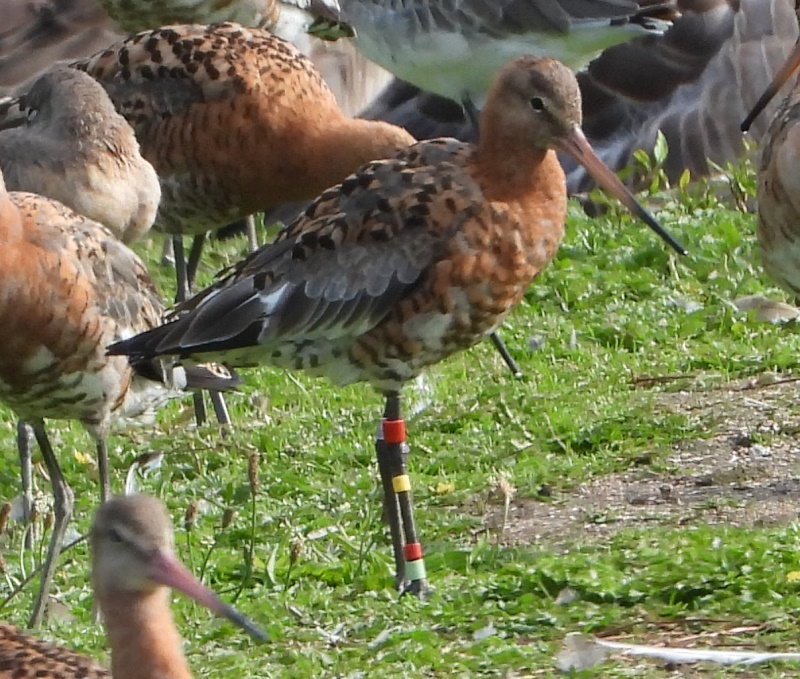
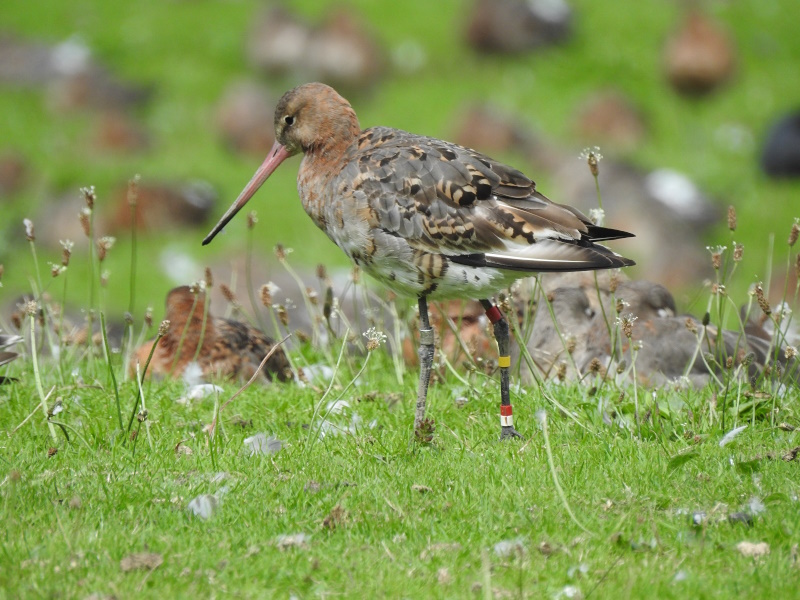
There were 43 records of 12 colour ringed Black-tailed Godwits in
August.
Five were ringed in Iceland, three in Belfast Lough, one in north-east
Scotland, one in Anglesey and two, pictured above, in north-west Spain.
R/YRL
Ringed at Pontevedra, north-west Spain, in December 2019.
This is a regular at Caldy post-breeding and has also been recorded
several times at Oakenholt RSPB. It's been seen back at the ringing
site in winter a couple of times, and in May 2023 was recorded breeding
in south-west Iceland. There are also single records of it at Woolston
Eyes and Marshside.
Recorded in late July and throughout August 2023 at Caldy.
R/YRW
Ringed at Pontevedra, north-west Spin, in January 2019.
Recorded at the ringing site up to April 2019 and again in January and
October 2020. It flew south early in 2022 when it was spotted on the
Portuguese coast in August 2022.
Recorded in late July and early August 2023 at Caldy.
Black-headed Gull
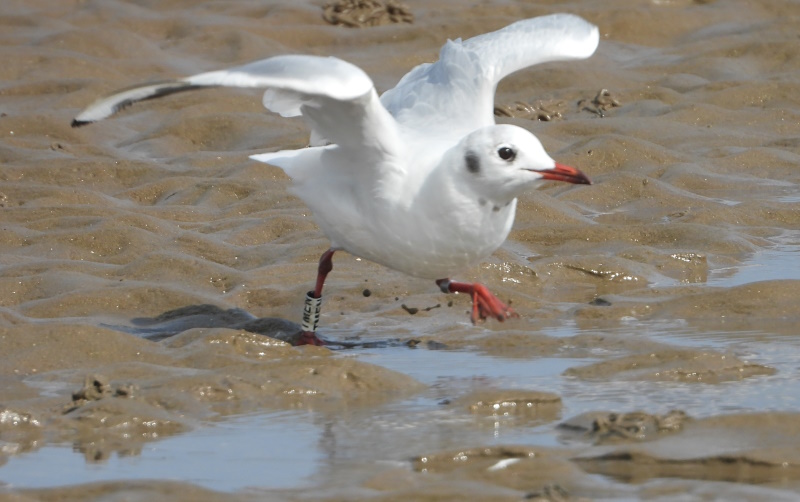
White Ring (TMEN)
Ringed in central Poland in April 2013, an adult male.
This bird was first recorded on it's favourite spot, the pontoon on
West Kirby Marine Lake, in September 2013. It's been recorded at West
Kirby, either on that pontoon or on the shore, every year since. The
earliest it has been recorded is July 7th and the latest is February
28th - a total of 70 records. Other records have come from Greenfield
Dock, Hoylake and Thurstaston, with just one record back in Poland - on
March 6th 2022 and thus we suspect it goes back to Poland to breed
every year.
This August 17th I was walking back from an
unproductive search for colour ringed Sandwich Terns off West Kirby
Marine Lake, and feeling a bit fed up due to the lack of birds. There
was a single Black-headed Gull close to the lake wall and only about 50
foot from me, so I thought I'd better have a quick look at it just in
case. I was amazed to find that it was our old friend TMEN having
survived both the ravages of bird flu and yet another journey to Poland
and back. I was doubly amazed as almost exactly the same thing happened
last year with the nearest gull to me being TMEN and also after an
unproductive trip to the shore!
Sandwich Terns
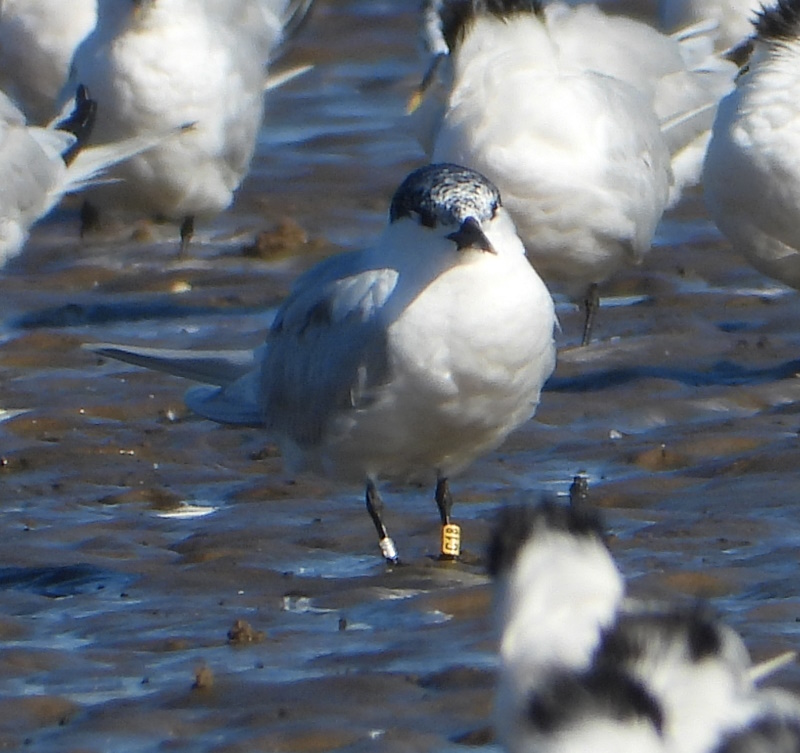

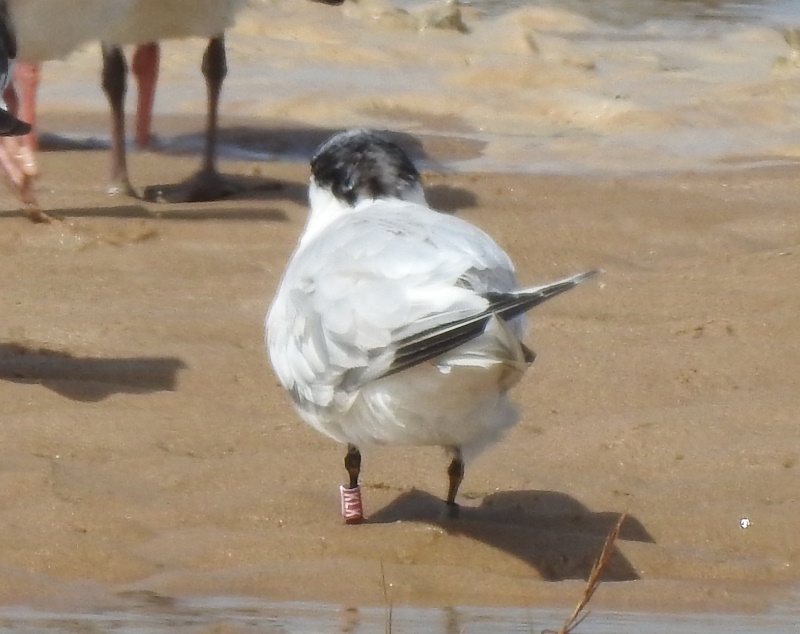
Top and middle by Richard Smith, bottom by Steve Hinde
Despite my poor experience on
August 17th, described above, it has actually been a very good summer
for colour ringed Sandwich Terns, including some very interesting life
histories. So much so that I feel they deserve their own article which
I will write either for next month or the month after - by which time
we will hopefully have seen a few more.
Rock Pipit

Blue CAF
Ringed on Hilbre on 04/08/2023, recently fledged.
Recorded:
Hoylake Shore (near Lifeboat Station) on 13/08/2023.
Hilbre on 15/08/2023.
Meols on 25/08/2023.
See August
2023 Newsletter for details about this project.
Colour Rings were recorded by Richard Smith, Stephen
Hinde, Alan Hitchmough, Alex Jones, Tony Ormond, Peter Haslem,
Colin Schofield, Richard Whitby, David Leeming, Anthony Ramsden, Steve
Williams, Les Hall and Roy Lowry.
Richard Smith
September Bird News

The stretch of North Wirral shore between Kings Gap
(Hoylake) and Meols certainly got more than it's fair share of good
birds in August, the star bird being Cheshire and Wirral's second
record of a Citrine Wagtail - seen off Meols on the 23rd. The first one
was at Red Rocks on May 5th 2014.
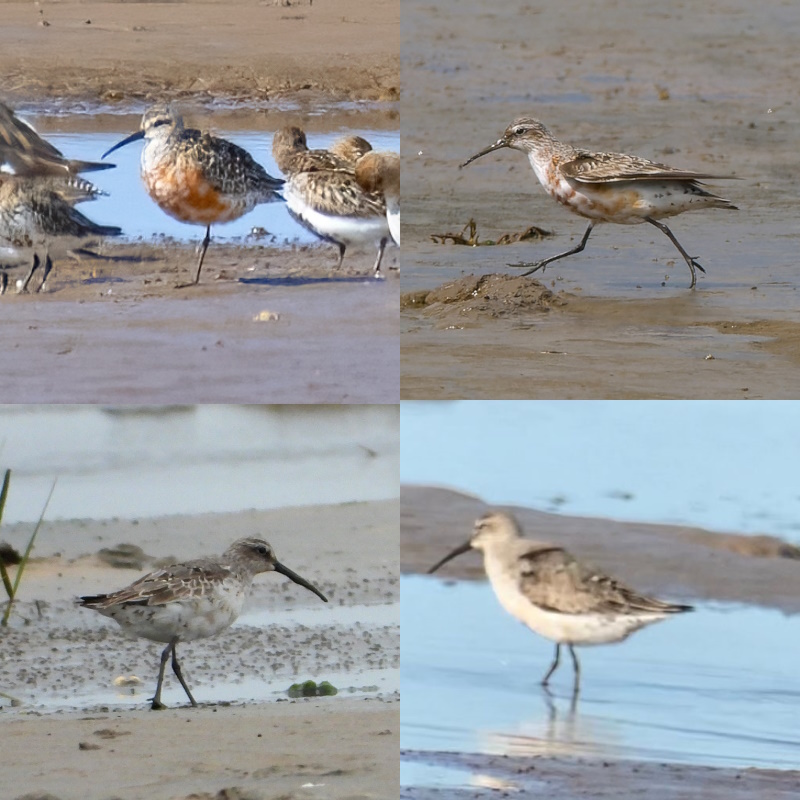
top left by Frank Burns August 22nd : top right by Mark Woodhead August 21st
bottom left by Richard Smith August 29th : bottom right by Sean O'Hara August 24th
Adult Curlew Sandpipers are rare here and we normally expect to see just one or two in the summer before the juveniles arrive in late August and September. But this summer has been exceptional. It started with four briefly seen at Burton Mere Wetlands on the 4th, a good number but the date was typical for adults on post breeding passage. Then one in summer plumage at Meols on the 17th was a nice surprise, more surprising was that numbers had increased to three by the 21st with between one and three then recorded daily right up to the 29th. Records of three aren't unknown and there were three at Hoylake on August 13th 2004 and at Hilbre on August 17th 2005, but the usual pattern is for them to be seen briefly before moving on. This year there was a total of 20 records (total of daily counts). The birds were in different stages of moult which helped when trying to estimate the total number of individuals which were present over the nine days they were here, and we reckoned at least six - four of which are shown above. We usually expect the first juveniles to arrive in the last week of August and two were seen briefly at Meols on the 28th, with at least one more on the 31st.
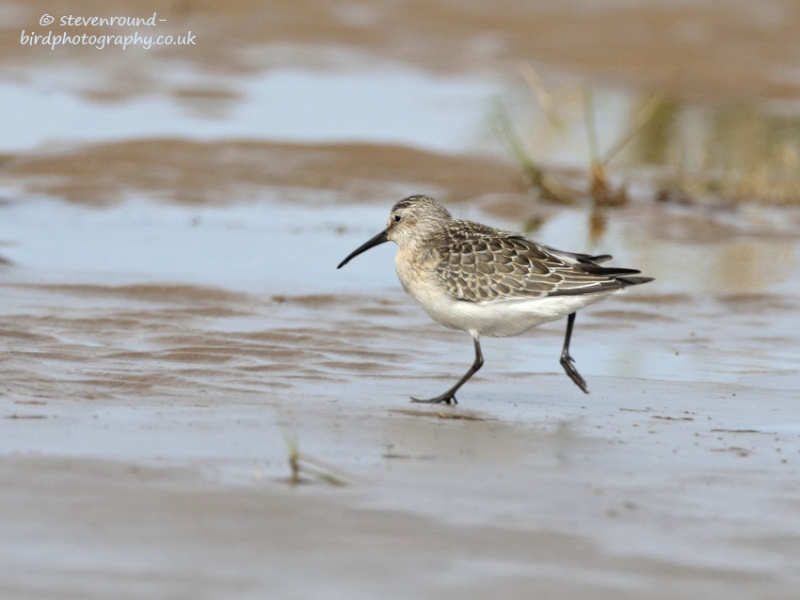
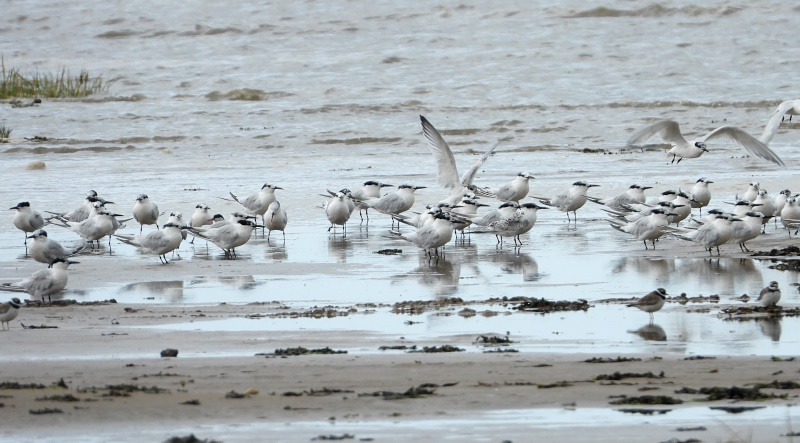
There were good numbers of Sandwich Terns throughout August, including
480 at Hoylake on the 2nd and 550 at West Kirby on the 29th, and there
seemed to be a good number of young birds. It was good to see a small
passage of Black Terns including nine past Hilbre on the 19th and six
off Hoylake the following day, with five there on the 21st. Gronant had
a Roseate Tern on the beach on the 10th and a Black Tern on the 28th.
I've not yet seen any official counts from the Little Tern colony at
Gronant but I'm expecting them to have had a good breeding season. 120
Little Terns, including 72 juveniles, were at Point of Ayr on the 20th,
with similar numbers on the sand bank off Hilbre a few days earlier.
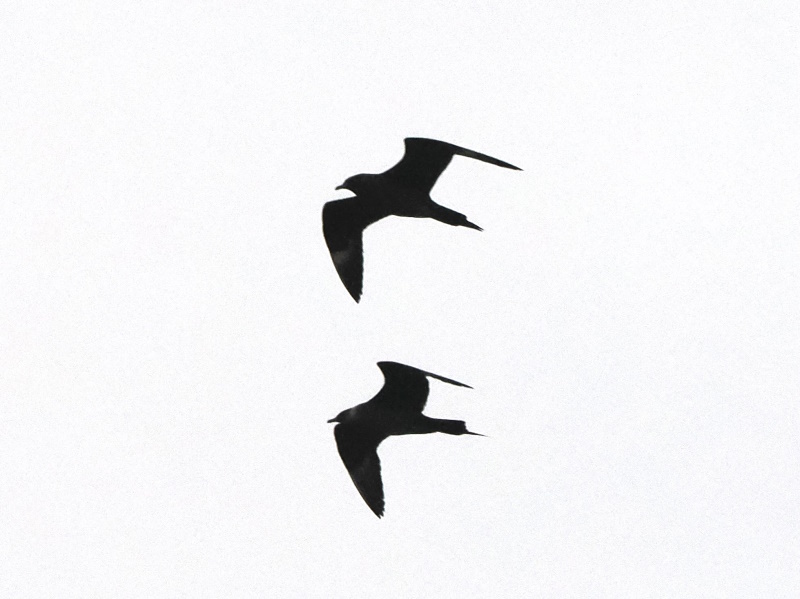
Some fresh westerlies in the last week of August
resulted in some good sea-watching, starting with a juv Long-tailed
Skua and six Arctic Skuas past Hilbre on the 27th. The 29th brought in
another juvenile Long-tailed Skua and four Arctic Skuas past Hoylake.
The next day a Leach's Petrel flew past Hilbre with five Arctic Skuas
past Gronant. Plenty of Gannets were flying past, as well.
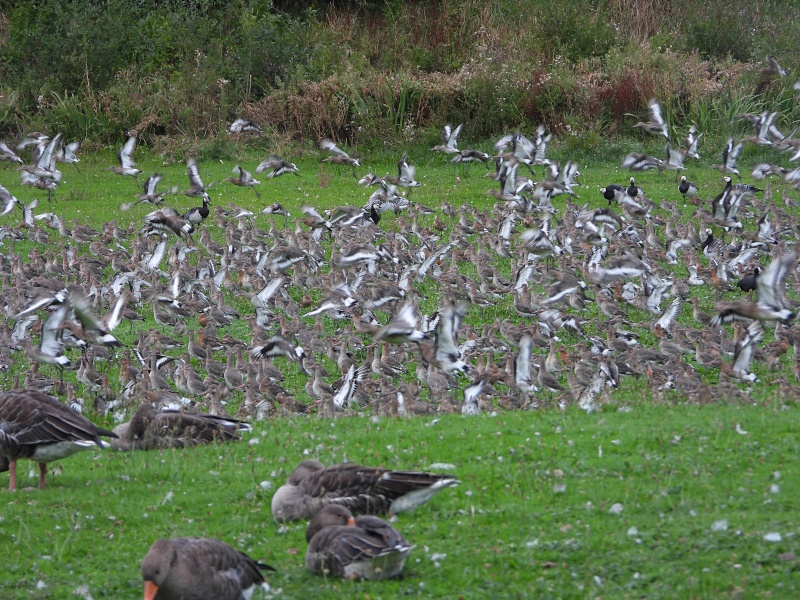
One of the most important sites in the UK for post
breeding Black-tailed Godwits undergoing moult is a small field just a
five minute walk from my house on the edge of Caldy. On the 20th I
counted 6,350 there, a site record. Just to put that into perspective -
in the 2021/22 Wetland Bird Survey Report only one count beat that
number, and that was for the whole of The Wash with 6,930 in September
2021.
This video of the Black-tailed Godwits will give you
an idea of just what an impressive sight this is - click here.

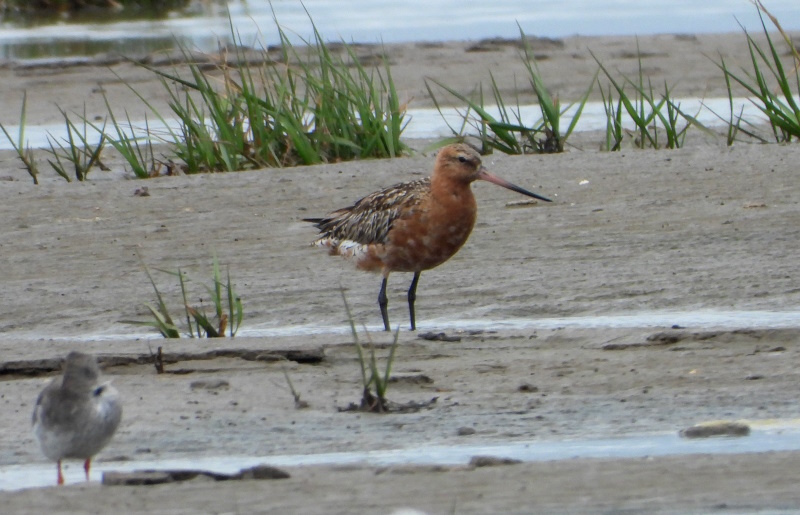
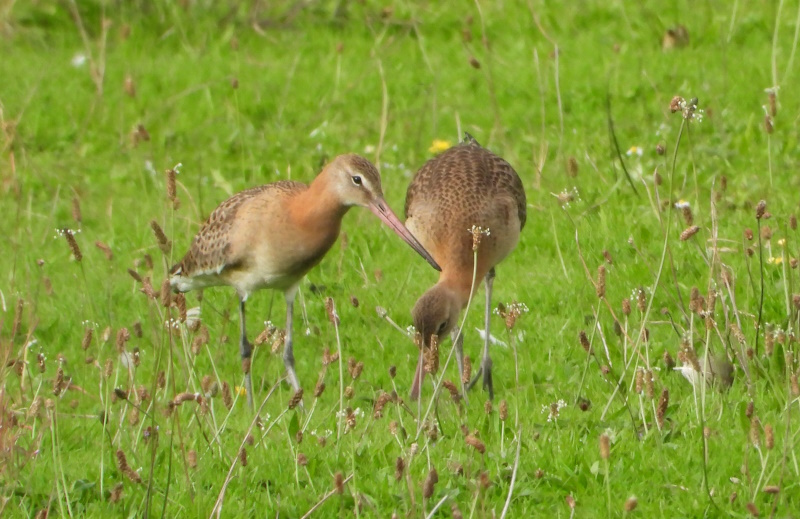

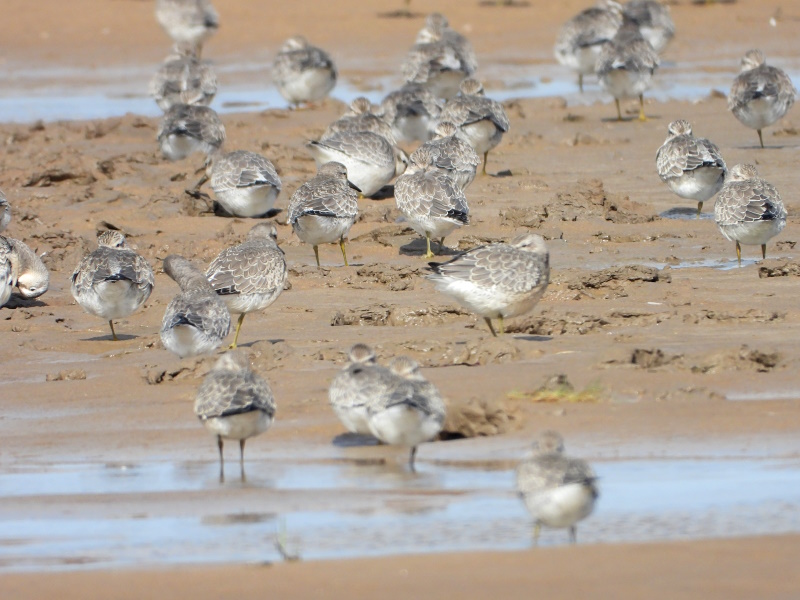
juvenile Sanderling and juvenile Knots - all photographed by Richard Smith, August 2023
One of the joys of watching the waders in August is seeing all the
different plumages. At the start of the month many adults are still in
full breeding plumage, such as the Knot and Bar-tailed Godwit above.
Then, just as the adults start to moult, looking rather scruffy, the
juveniles arrive in their brand new pristine plumage. It's always good
to see juveniles knowing that they've had a successful breeding season,
but we were astonished over the high tides at Hoylake on the last two
days of the month to see two thousand juvenile knots when normally a
count of 100 at this time of year would be considered a good number.
There were plenty of juvenile Dunlins and Sanderlings as well, great to
see.
What to expect in October
We often get gales in October and, particularly early in the month, that should bring in plenty of sea birds including Leach's Petrels and skuas, and maybe Sabine's Gulls and Grey Phalaropes if we're lucky.
Out on the estuary there will be thousands of Shelducks with the Dee the most important site in the country for them at this time of year. Stand on top of the cliff at Thurstaston and you will see Dawpool Bank covered in them.
As described above there will be a lot of
Pink-footed Geese but Brent Geese will also be arriving, these are best
seen around Hilbre and West Kirby Shore and may reach 200 or so by the
month-end.
The Marsh Harrier roost will be in double
figures, it can either be at Parkgate or Neston, or both. Get there
late afternoon and you may see ten or more in the air together. Hen
Harriers and Short-eared Owls should also be on view.
October is the month we usually see Yellow-browed
Warblers, numbers can vary greatly and often just one or two are
recorded, but in 2016 they seemed to be everywhere! http://www.deeestuary.co.uk/news1216.htm.
East winds can bring in plenty of passerines
to our coast on migration - early morning is best and on a good day of
'Vis Mig' hundreds, perhaps thousands, of Redwings, Fieldfares,
Starlings and finches will be flying along the coast in flock after
flock. October 2022 was spectacular for Redwings. Other passerines
which often turn up are the first Snow Buntings of the winter, and a
Black Redstart or two may turn up.
Forthcoming Events
October Highest Spring Tides (Liverpool)
Also see Tides page.
1st October, 13.08hrs (BST), 9.8m.
2nd October, 13.45hrs (BST), 9.6m.
29th October, 11.03hrs (GMT), 9.7m.
30th October, 11.42hrs (GMT), 9.7m.
Forthcoming Events
Also see events at https://events.rspb.org.uk/deeestuary